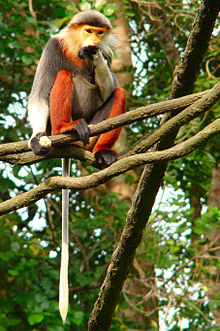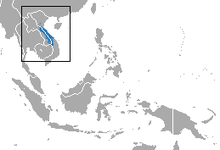Red-shanked douc
| Red-shanked douc[1] | |
|---|---|

| |
| Scientific classification | |
| Domain: | Eukaryota |
| Kingdom: | Animalia |
| Phylum: | Chordata |
| Class: | Mammalia |
| Order: | Primates |
| Suborder: | Haplorhini |
| Infraorder: | Simiiformes |
| Family: | Cercopithecidae |
| Genus: | Pygathrix |
| Species: | P. nemaeus
|
| Binomial name | |
| Pygathrix nemaeus (Linnaeus, 1771)
| |

| |
| Red-shanked douc range | |
The red-shanked douc (Pygathrix nemaeus) is a species of Old World monkey, among the most colourful of all primates. It is an arboreal and diurnal monkey that eats and sleeps in the trees of the forest.
Geographic range and habitat
The red-shanked douc is native to Indochina; Vietnam, Southern Laos and possibly Northeastern Cambodia. Before 1967, the douc was completely unstudied. Doucs are found in a variety of habitats: from lowland to mountainous terrain up to 2,000 m (6,600 feet), semi-deciduous, primary and secondary rainforests, in the mid to upper levels of the canopy. They occasionally get on the ground to drink water or eat dirt that contains minerals.
Description
Like other doucs, the red-shanked douc is a long, slender monkey. The male has an average head and body length of 61 cm (24 in), and the female averages 54.5 cm (21.5 in) long, with a tail that measures 55.8–76.2 cm (22.0–30.0 in) long.[3][4] Males weigh on average 11 kg (24 lb), and females 8.44 kilograms (18.6 lb).
The red-shanked douc is the most colorful monkey among all species of primates. They are considered “Queen of primates” thanks to their distinctive and unique appearance. Their forearms are white, upper legs black to grey and the lower legs a deep red while hands and feet are black. The monkey’s yellow-orange face and ears appear to be powdered with theatrical makeup, and the eyelids appear to be dusted with a powder-blue eyeshadow. Dark, almond-shaped eyes view the world, and from a modest nose, tiny nostrils inhale the fragrance of the forest habitat. Long, white whiskers (more generous in males) adorn the chin and frame the monkey’s alien-like face. A wide black band stretches across the monkey’s forehead. Belly and back are grey. There is a slight difference in rump markings between genders: the male has round white spots above the triangle of white on its rump, while the female does not.[3] Males of all ages have a white spot on both sides of the corners of the rump patch, and red and white genitals. Shortly, the douc’s fur is a harmonious combination of the 5 colors: black, grey, white, brown-red and orange. Due to this fact, the species is also called the five-color douc. A baby douc has yellow-brown fur with black face. Between 8 and 24 months of age, the colors of the fur and face have changed gradually to form colors of the mature one.
Behavior
The doucs are, like all monkeys, social animals. They live in groups with an average size of 4 to 15, but groups of up to 50 have been recorded. A group usually consists of one or more males and approximately two females per male. Both males and females have their own hierarchies and males are dominant to females. Both males and females will eventually leave the group they were born into.

Like all other Old World monkeys, its tail is not prehensile. It uses its tail solely for balance, and it uses its arms and legs to move through the forest along established routes. When on the move, the group is led by adult males, with juvenile males bringing up the rear and the females and infants staying safe in the middle. This douc is an aerial specialist, moving high up in the canopy. It is very agile and frequently makes breath-taking leaps of up to 6 meters (20 feet), leaping with its arms outstretched over its head, pushing off with its legs and landing on two feet.
When the group is untroubled, the red-shanked douc will move noisily from branch to branch through the forest, crashing through foliage, swinging under branches and leaping with two feet together, displaying its remarkable sense of balance. But when a group is disturbed, by either a predator or other dangers, it can flee soundlessly through the trees, away from danger. If it is startled, it may give loud barks and rush around the trees slapping branches with its hands and feet. In contrast to their noisy travel, doucs spend most of their time quietly eating, digesting their bulky food, dozing and grooming each other's fur.
This monkey communicates using facial expressions. It has a specific play face with the mouth open, teeth partially bared and chin thrust forward. Sometimes, it closes its eyes and paws blindly towards another douc with remarkable disregard for the hazards of doing this when up a tree. A fixed stare is a threat display. A grimace with the mouth open and the teeth exposed is a submissive gesture given in response to a stare. It is also used to initiate grooming or play. The red-shanked douc has a low-pitched growl that is given as a threat, and a short, harsh distress squeal.
This douc has been rarely observed in the wild and very little is known about its wild mating and breeding habits. Before mating, both genders give a sexual signal with the jaw forward, eyebrows raised and then lowered, and a head-shake. The female makes the first move, lying face-down on a branch, eyeing her chosen mate by looking over her shoulder. The male returns with a stare and may turn to look at another spot he considers more suitable for mating. Single-mount and multiple-mount matings have been reported.
Mating takes place from August to December. The pregnancy lasts between 165 and 190 days, resulting in the birth of a single offspring just before fruiting season of some favorite foods. Twins are very rare. The young are born with their eyes wide open and they cling to their mothers instinctively. The baby's body colouration is lighter than an adult's. Its short, downy grey hair has a dark stripe down the back and it has a black face and two pale stripes beneath the eyes. As it grows older, its body darkens while its face lightens, achieving adult colours at 10 months. In captivity, other group members may look after an infant, and other females may even suckle it. In one study, an orphaned infant was fed by two females in the group and also cared for by a male. Females reach sexual maturity at about 4 years, while the males reach it at 4–5 years. They have a lifespan of about 25 years.

The red-shanked douc is diurnal and eats and sleeps in the trees of the forest. Its diet consists mostly of leaves high in fibers. Belonging to the subfamily Colobinae, or leaf-eating monkeys, it has a large stomach which is divided into sacs containing bacteria that break down the cellulose in the leaves through fermentation, giving the douc its pot-bellied look. This also makes it burp frequently from the resulting gas. It prefers to eat small, young and tender leaves, but will also eat fruit like figs, buds, petioles, flowers, bamboo shoots and seeds. It gets all the liquid and protein it needs from the food it eats and doesn't need to descend to the ground to drink. This monkey eats 50 different plant species but no animal prey. It is a messy and chaotic feeder, dropping much of its food onto the forest floor: old leaves, under-ripe or over-ripe fruits. It eats peacefully together, not quarreling over food, and has been known to share it with others. Often, it will share the same clump of foliage and may even break pieces off and hand them to each other, a type of active generosity that is rare among Old World monkeys. It does not have cheek pouches.
Conservation
According to the most recent assessment of IIUCN Red List, the red-shanked douc is critically endangered. The species is listed in CITES I which prohibits international trade.
So far, there is no research yet on the total population of red-shanked doucs in the Indochina. In Son Tra, Vietnam, the douc population is approximately 1300 individuals.
Hunting is currently the major threat to this species, most often for subsistence use and traditional medicine. Local people often hunt the species for food, pets or making glue. For the population in Son Tra, habitat loss due to development plan poses as the biggest risk to them.
References
- ^ Groves, C. P. (2005). Wilson, D. E.; Reeder, D. M. (eds.). Mammal Species of the World: A Taxonomic and Geographic Reference (3rd ed.). Baltimore: Johns Hopkins University Press. p. 173. ISBN 0-801-88221-4. OCLC 62265494.
- ^ Coudrat, C.N.Z., Quyet, L.K., Duc, H., Phiaphalath, P., Rawson, B.M., Nadler, T., Ulibarri, L. & Duckworth, J.W. (2020). "Pygathrix nemaeus". IUCN Red List of Threatened Species. 2020: e.T39826A17941247. Retrieved 10 July 2020.
{{cite journal}}: CS1 maint: multiple names: authors list (link) - ^ a b Gron, K. J. (2009). "Primate Factsheets: Douc langur (Pygathrix)". Retrieved 2012-04-20.
- ^ Nowak, Ronald M. (1999). Walker's Mammals of the World. Vol. 1 (6th ed.). JHU Press. ISBN 978-0-8018-5789-8.

